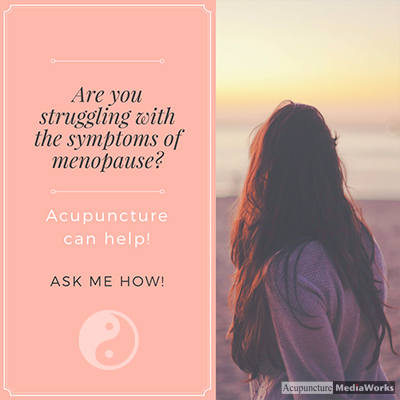Menopause is a natural, physiological cycle that occurs in all women. Conventional medical treatments only address various symptoms and signs associated with menopause. However, symptoms and signs are just one part of the whole picture.
Acupuncture and Chinese medicine understand that symptoms and signs are merely indications of an imbalance deep within the body. This 5,000 year-old healing art focuses upon correcting underlying imbalances that have occurred over the years. These imbalances, if left unchecked, will result in a variety of symptoms and signs normally associated with a Western diagnosis of menopause.
Acupuncture and a Woman’s Natural Process
Menopause signifies “a change” within a woman’s life. This change occurs because a woman’s body chemistry is shifting. Chinese medicine recognizes this chemistry change as a natural process.
Estrogen is similar to what acupuncturists call Jing Qi. Jing Qi is like a gift that is given to all of us at the time of conception. It is the battery that provides us with the basic energy to power all our life functions. When Jing Qi is abundant, our ability to adapt to disease, illness and stress is optimal.
- Overexertion
- Poor dietary habits
- Excessive activities
(sexual, alcohol, drugs, late nights)
As we age, our supply of Jing Qi energy is slowly drained. Generally, Jing Qi naturally begins to decline between the ages of 35 to 60, although some people drain it faster than others. When Jing Qi declines, the Organ Systems within our body become unbalanced. This leads to various symptoms and signs, such as graying hair, loss of libido, weakness of knees, urinary difficulty, poor memory, backache and fatigue.
Another factor that can contribute to menopause is an imbalance in Yin and Yang energies. One possible scenario is an imbalance caused by the slowing of the flow of Yin. Yin can be thought of as the cooling system of the body. When this cooling system declines, heat symptoms will naturally arise, leading to night sweats, restlessness, hot flashes, mood swings, heart palpitations and insomnia.
The decline of Yang energy can also lead to imbalance. Yang represents the warming and metabolizing functions of the body. When Yang is unbalanced, symptoms may include water retention, cold hands/feet, weight gain, indigestion, hypertension, or raised cholesterol levels.
Left untreated, a decline and imbalance of Jing, Yin or Yang will lead to the symptoms and signs that are normally associated with a Western diagnosis of menopause.
An acupuncturist will conduct a thorough evaluation and a complete health history. The symptoms, signs and other information that is gathered are pieces of the diagnostic health puzzle. Putting together this puzzle allows a practitioner to develop a unique treatment plan that will address each patient’s individual concerns.
When treating menopausal symptoms, an acupuncturist must first determine where the energy has changed, and what organ systems have become unbalanced. Once this is known, various natural therapies such as acupuncture, herbs, meditation, Qi Gong and diet can be used to correct the imbalances.
Acupuncture and Chinese medicine offer a safe, natural, drug-free and effective way to address menopause. Treatment supports the healing energies of Jing, Yin and Yang, providing the body with the building blocks it needs in order to nourish, heal, and regain balance.
 Acupuncture for Menopause
Acupuncture for Menopause
A meta-analysis of research confirms that acupuncture can significantly help women with the distressing symptoms of menopause, including the frequency and severity of hot flashes (Chui, 2015).
Acupuncture Points:
● Du 24 – located at the center of the forehead a little bit behind the hairline into the scalp. Activate this point by rubbing away from your face toward the back of the head.
● Ht 6 – the primary point for night sweats and hot flashes. Located a little bit above the wrist in line with the inside edge of the pinky finger about a pinky finger width above the wrist crease. Because the point is very small and precise press with your thumb in a clockwise rolling motion and press with the edge of your finger toward the point.
● Sp 6 – also called Three Yin Crossing helps hot flashes and night sweats; insomnia, high blood pressure in turn helping to calm the mind. Sp 6 is found by placing your pinky finger on the center of the inner ankle bone (malleolus) with your other fingers lying along the inner ankle. Use your other hand to find Sp 6 on the center of the upper ankle along the edge of the bone right next to the index finger.
● Ki 1 – Bubbling Spring is the strong sedating and cooling point often used for cooling signs of heat including hot flashes, high blood pressure and insomnia. Ki 1 is located below the ball of the foot between the second and third toe. You can stimulate Ki 1 by pressing your foot on a small ball or marble while holding another point.
Aromatherapy for Menopause
Clary Sage helps both to relax tension while reducing fatigue.
Roman Chamomile reduces heat and inflammation. It’s also good for frustration, resentment and depression.
Peppermint is a cooling, analgesic (reduced pain) while also being refreshing.
Use the essential oils by themselves or blend together. Place a few drops in an aroma vaporizer or place one drop of each oil in a dab of lotion in your hand, rub the lotion and oils together and then rub the back of your neck and feet. Wash your hands afterwards to avoid getting peppermint on your face or in your eyes. Try using aromatherapy before your hot flashes typically start; e.g. if you typically have most of your hot flashes after 5 p.m., then try using aromatherapy two to three hours before hand, and then again every two to three hours until you go to sleep. If you wake up in the middle of the night repeat your aromatherapy treatment.
Yoga for Menopause
Research shows favorable results for helping women manage the symptoms of menopause. One study which focused on restorative yoga found that after 7 restorative yoga classes, the frequency of hot flashes were reduced by 30% and the severity of the hot flashes were reduced by 34% (Cohen, 2007). Another study found that yoga helped reduce insomnia and other menopausal symptoms (Afonso, 2012 and Newton, 2014).
Forward Bend: Uttanasana
Stand with your feet parallel hip width apart. Bend your knees slightly, activate the core belly muscles by pulling the navel and then hinge forward at your hips joints on the exhale. Hang your torso forward, breathing into the back of your legs and lower back. Breathe deeply enough to feel your rib cage expanding. Keep your knees bent if your hamstrings are very tight. Hold for 30 seconds up to three minutes. You can either come in and out of the pose three to six times or hold the poses up to three minutes. This is a very calming and cooling pose. Practice four to eight hours before you typically have hot flashes and not during a hot flash.
*This pose is contraindicated for those with uncontrolled high blood pressure, low blood pressure, dizziness or detached retinas. If you have these conditions you can do a seated forward bend.
Oriental Medicine (OM) Nutrition Tips
Avoid or limit foods that are warming and drying, such as: coffee, red wine, sugar, chili peppers, turmeric, curry and dried ginger.
Replace these with things that are more cooling or neutral in thermal nature, such as: green tea, beer, honey, fresh ginger, saffron, sorrel, garden cress, chervil and most other savory herbs.
Drink flower tea! Chrysanthemum tea is a very popular summertime tea in Asia because it is so well known for its cooling properties. It’s also helpful for headaches, dizziness, high blood pressure, chest pain, fevers and colds. You can add chrysanthemum flowers to your morning green tea and in the evening combine it with chamomile tea for extra flower power cooling benefits!
